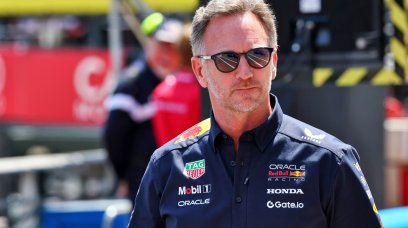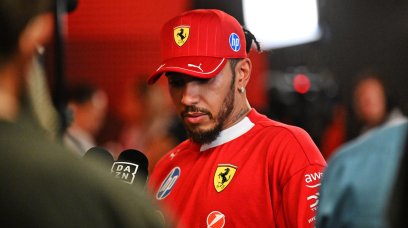Sunday
Arrive at circuit at 8am to beat the traffic and ensure a prime parking spot as I plan on leaving the circuit within two hours of the race finishing to catch my flight. It proves a very wise decision… The paddock is quiet - the 10am team curfew restricts access to non-race personnel - so I take a walk to compare the various team hospitality units. My mind goes back to the early 2000s when teams generally debuted their paddock palaces at this race. Paid for by their sponsoring tobacco companies, it was a matter of 'mine is bigger and glitzier than yours'. Now, though, a number of the units are a decade old yet are still fit for purpose. Indeed, the white Sauber 'tent' is fundamentally unchanged from when BMW owned the team – and thus harks back to 2005. McLaren's hospitality unit, while seemingly new, is a repurposed, downsized version of its former 'brand centre'. Where the original was based around five pop-up trailers, the latest is built around three of those units yet does the trick perfectly. Crucially in these 'green' times, it requires 'only' seven trucks to transport various constituent parts across Europe – down by half from 14, but some could argue that is still too many. I believe, though, that Red Bull is again planning to tow its floating Energy Station to Monaco from its base in Imperia on Italy's Mediterranean coast. This year marks the first time this mega facility has been used since 2019 and a full-on Monaco GP welcome party is scheduled for the weekend. It will, though, be hosted Friday rather than Thursday due to the three-day (rather than five- of the past) weekend programme.
Gradually Monaco is being forced to fall in line with other races, and I hear that the next contract - currently in negotiation - demands that the local TV broadcaster drops its right to produce race footage, with F1 TV taking control. Ditto trackside 'bridge and board' signage rights: these revert to F1 under the new contract, as is the practice with other events. Talking TV: on Saturday I delved into the use of video drones after F1 showed test footage, and Roberto Dalla, Managing Director of F1's Media and Technology Centre, kindly offered to run me through their plans at noon Sunday. Thus, I chat with Roberto, whom I've known for many years via his previous role as CEO of Magneti-Marelli's motorsport division and prior to that as head of Ferrari's electronics department. Before getting into the nitty-gritty of the drone programme, Roberto takes me for a tour of the MTC, the trackside TV production studio that also provides all timing services. The total department consists of around 320 people, of whom 180 are on site, with the balance working remotely from Biggin Hill in Kent, England. All departments are, though, totally interconnected via giant screens and teleconferencing links. Covid forced a total rethink of the operation, and Roberto proudly tells me remote working enabled them to reduce travelling staff by around a quarter (70 heads) and cut freight by 50 per cent. I'll bring you a full rundown on the entire TV operation in the near future, but suffice to say it's a fascinating place to visit. Re drones: before the FIA permitted them to be deployed F1 needed to obtain special clearances on safety grounds, with geoblocking preventing the craft from flying in unsafe areas. It is not difficult to imagine the potential dangers of a drone striking a driver at 300kmh, so it was not an easy sell.
Drones are, though, here to stay and the long-term objective is to replace helicopter footage with drone shots for both cost and sustainability reasons, but Roberto admits it will take time, particularly as current battery capacity suffices for a mere 10 minutes of flying at a time. However, Roberto expects drone usage to accelerate both technologies, as F1 has done in other fields. He is aware that video quality needs to improve substantially, hence the (very) public tests, and I question why they chose F1 and not F2, F3 or Porsche as trial categories. He believes F1 alone provides the authenticity they seek and says the original plan had been to conduct tests away from the public eye, but as F1 bans in-season testing they have little choice but to run tests during Grand Prix weekends. Once post-race media sessions are done I head for the car park, where it takes a minute to exit, but then the traffic is grid-locked. After 30 minutes of zero movement, a local suggests I turn 180 degrees – possible because the circuit refuses to institute a one-way system. At least the traffic flows freely, but after diligently following all signs and traffic officer directives for an hour (roughly 12km), I end up back within a kilometre of the circuit! The net effect is that my 50km journey takes over three hours from start to returning the rental car - but I believe congestion lasted well into the night so I'm fortunate to have made it to the airport and home at all - although a flight delay means I eventually reach home at 2:30am…
https://twitter.com/RacingLines/status/1528443694860406784
Here’s proof of #SpainGP traffic incompetence: after standing for 1 hour @f1 personnel car park Im directed out & follow signs once I hit public road. Attempted deviations met with waved fingers. After an hour/12kms route returns me to within 1km of where I’d joined! — Fritz-Dieter Rencken (@RacingLines) May 22, 2022
Most read









